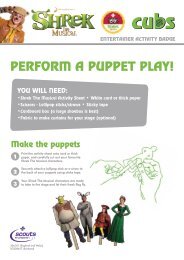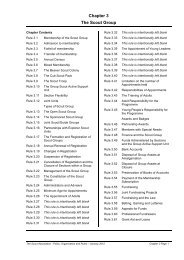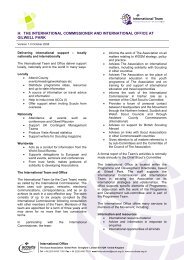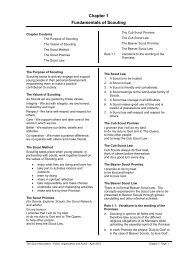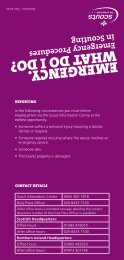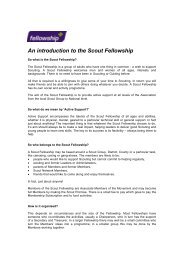SCOUT ELECTRONICS BADGE GLOSSARY
SCOUT ELECTRONICS BADGE GLOSSARY
SCOUT ELECTRONICS BADGE GLOSSARY
Create successful ePaper yourself
Turn your PDF publications into a flip-book with our unique Google optimized e-Paper software.
<strong>SCOUT</strong> <strong>ELECTRONICS</strong><strong>BADGE</strong><strong>GLOSSARY</strong>Alternating current (AC)Mains electricity is supplied as AC. AC switches its direction of flow at regular intervals – thesupply to UK homes switches at 50 cycles/second (50Hz). For some devices, AC needs to beconverted into direct current in order to be usable. This is called rectification. UK domestic AC issupplied at 230V.CapacitorCapacitors are components that store charge. The higher the capacitance, the more chargethey store. Capacitance is measured in Farads (F).Capacitors need to charge before they will allow electricity to pass out of them and arounda circuit. This makes them useful in timing circuits where they are combined with resistors tointroduce a delay in the flow of current round the circuit. They are also used to smooth outvarying DC currents.There are two main types of capacitor:• Non-electrolytic (also known as non-polarised or ceramic) capacitors – these havecapacitance up to 1μF• Electrolytic (or polarised) capacitors – these have higher capacitance than ceramiccapacitors• Electrolytic capacitors have a positive and negative terminal and must be connected intocircuits the right way round. The negative terminal is marked by arrows painted on thecapacitor body.For small capacitors printing onto the capacitor is difficult so the value is given as a code where:• 1st number is the 1st digit• 2nd number is the 2nd digit• 3rd number is the number of zeros to give capacitance in pico Farads (pF - 1pF = 1 trillionthof a Farad).DiodesDiodes will let electricity flow through them in one direction only. They are used to protectelectric circuits and as part of logic gates.There are four commonly used types of diode:• Light Emitting Diodes (LEDs)• Signal diodes – used in radio and television receivers and in logic gates• Rectifier diodes – used to convert an AC current to DC, for example in a car’s alternator.• Zener diodes – designed to let current through the “wrong” way at a set voltage. They areused as voltage regulators.Diodes must be connected the right way round. The negative terminal (cathode) is indicated bya line on the diode body.In circuit diagrams, the arrow on the diode symbol shouldpoint in the direction of current flow.Scout Electronics Badge - GlossaryDiode circuit symbolshowing current flowfrom left to right.
Direct current (DC)In DC, the current flows constantly in the same direction. Batteries provide a directcurrent.Integrated circuit (IC)Integrated circuits are tiny, complex circuits etched onto asemiconductor chip. The chip is protected by a plastic case withpins connected to the circuit inside. The case has a small semicircularnotch at one end. With this notch at the top, the pins arenumbered anticlockwise starting top left.1 82 73 64 5In circuit diagrams the pin numbers are rearranged to make the diagram easier to read.Heat from soldering can easily damage these chips, so they are usually supplied with aDIL (dual in line) socket which the chip fits into. The DIL should be soldered without thechip, and then the chip can be pushed in place.LEDsLEDs are available in red, orange, amber, yellow, green, blue and white. The colour isdetermined by the semiconductor used. Since LEDs are diodes, they will only work whenwired in the correct direction.The terminals can be identified in two ways:• The wire for the negative terminal (cathode) is shorter than that for the positiveterminal.• There is also a small, flattened area on the LED casing on the cathode side.LEDs need a current of around 20mA (0.02A). If the current is too high, they will burnout. You should check the forward voltage of any LEDs you use.The resistance values needed for LEDs in circuits is calculated using the equation R = (VS- VL) / I (see Ohm’s Law) where:• R = resistance• VS = supply voltage• VL = LED voltage• I = LED current (note this is in Amps, not milliamps - 20mA = 0.02A)Scout Electronics Badge - Glossary
TransistorTransistors are one of the most important inventions of the 20th century. Without themwe would not have modern electronics.The main uses of transistors are:• As a voltage sensitive switch that turns on and off parts of a circuit, for example inresponse to changes in a sensor.• As signal amplifiers which take a signal from a low current device and use them toswitch on a high current device.Transistors have three terminals known as the collector (C), the emitter (E) andthe base (B).EB CThe base, which is the middle terminal of the three, controls the transistor, switching iton or off. When the electricity reaching the base hits a threshold value, a small amountof electricity flows from the base to the emitter. This switches turns the transistor froman insulator into a conductor and allows a current to flow through the circuit from thecollector to the emitter.555 TimerThe 555 timer is a particularly useful and common eight-pin integrated circuit. A typical555 timer contains 25 transistors, two diodes and 15 resistors.It has three main modes:• A monostable output – the circuit switches on for a period and then switches offagain.• An astable output – the circuit switches on and off in a repeating cycle.• A bistable output – a trigger turns the circuit on and it stays on until another triggerturns it off.0V 1trigger 2output 3reset 4555timer8 +4.5 to 15V7 discharge6 threshold5 controlThermistorA thermistor is a type of resistor that is sensitive to temperature. With most thermistors,resistance decreases with increasing temperature.Scout Electronics Badge - Glossary



